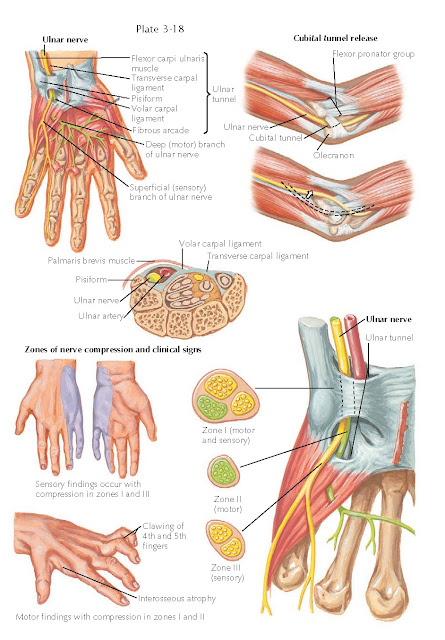CUBITAL TUNNEL
SYNDROME
Ulnar nerve compression at the elbow (cubital tunnel syndrome) is the
second most common compression neuropathy in the upper extremity. The ulnar
nerve runs posterior to the medial epicondyle and can be compressed at several
points along its course. Patients initially complain of numbness and tingling
most often in the small and ring fingers. As symptoms progress, medial elbow
pain becomes more prominent, as well as clumsiness in the hand. Advanced cases
of ulnar nerve compression at the elbow will demonstrate atrophy of the
intrinsic muscles of the hand (most obvious involving the first dorsal
interrosseous) and clawing of the fourth and fifth digits. Physical examination
focuses on a detailed sensory examination and muscle testing of the intrinsic
muscles of the hand. Instability of the ulnar nerve with elbow flexion should
be evaluated. A Tinel sign over the ulnar nerve in the cubital tunnel as well
as elbow flexion/compression testing can help localize the location of ulnar
nerve compression at the level of the elbow. Electrodiagnostic testing can help
make an accurate diagnosis and evaluate for more proximal and/ or distal points
of compression.
Initial treatment in a patient without
weakness/atrophy consists of diminishing traction and compression of the ulnar
nerve at the cubital tunnel. Night-time splinting with the elbow at
approximately 30 degrees, an elbow pad during the day to avoid direct trauma to
the nerve, and activity modification often leads to dramatic symptom relief.
Patients failing at least 3 months of consistent nonoperative treatment and/or
patients presenting with more advanced symptoms should be considered for
operative decompression. There are numerous surgical options from in situ
decompression to medial epicondylectomy to anterior
transposition of the ulnar nerve either subcutaneous or submuscular. Recent
reports have demonstrated positive results with endoscopic ulnar nerve
decompression, but further studies are needed.
Less commonly, the ulnar nerve can
be compressed at the level of the wrist (at the Guyon canal). The symptoms are
similar to those of cubital tunnel syndrome, but medial elbow pain and numbness
along the dorsum of the hand are absent. The ulnar nerve
can be compressed at different points in reference to the hook of the hamate,
and symptoms can vary from pure motor or sensory changes to combined losses.
Physical examination includes a positive Tinel sign at the ulnar wrist, and
careful palpation must evaluate for masses (ganglion/lipoma) and rule out
hypothenar hammer syndrome. Conservative treatment is the initial management,
followed by surgical decompression.





